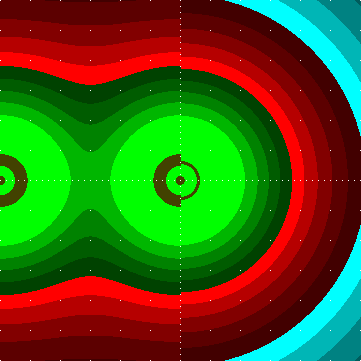



|

|

|
| In left plots, specific illuminances by a continuous row of luminaires spaced 5 and 6 heights are shown in their left halves (right half concerns a single luminaire). | The right plot is for a single luminaire, unrotated. | |

Values below the scale are illuminance / 1 lx. This is for (unrealistic) “unit” case that luminaires would have lamps producing 1 klm only, would be point-like and just 1 m over the terrain.
# IESNA: LM-63-1995
# [TEST] 766062
# [DATE] 6/14/91
# [MANUFAC] COOPER LIGHTING
# [LUMCAT] HMX40SXXNM
# [LUMINAIRE] 400W HPS TYPE V HIGH MAST
# [LAMP] 400W HPS CL E-18
# [_REFLECTOR] ANODIZED SPUN ALUMINUM
# [_REFRACTOR] NONE
# [_SOCKET POSITION] VERTICAL BASE UP
# [_LAMP LUMENS] 50000
# TILT=NONE
# Bulbs: 1, 50000 lm each
# Number of measured angles: 31 vertical, 1 horizontal ones
# Photometric type: 1, Units type: 1
# Luminous opening diameter (and height?): 2.330 ( 2.000 )
# Ballast factor: 1, Input power: 400 W
# Source file: hmx4snm.ies
# Luminaire flux = 37499 lm,
# 75.0 % of the bulb flux
# between 75 and 90: 14.5 % of the luminaire flux
# - this part causes just GLARE in case of road lighting and similar purposes
# 80deg and above: max 88.8 cd / 1000 lm , 5.0 % of the luminaire flux
# 90deg and above: max 0.2 cd / 1000 lm , 0.0 % of the luminaire flux
# CutOff Type: Full_CutOff
# 62.5 deg to <67.5 deg: max 267 cd / 1000 lm,
# 67.5 deg to < 76 deg: max 274 cd / 1000 lm,
# maximum spec. lum. intensity 274 cd / 1000 lm
# The following table gives luminous intensities which would be produced
# using a hypothetic bulb giving a luminous flux of 1000 lm (i.e., cd/klm):
0.0 31.9
5.0 35.6
15.0 27.1
25.0 41.2
35.0 57.1
45.0 82.9
50.0 107
55.0 147
60.0 207
62.5 244
65.0 267
67.5 274
70.0 257
72.5 224
75.0 181
77.5 133
80.0 88.8
82.5 54.8
85.0 29.0
87.5 8.9
90.0 0.2
95.0 0.0
105.0 0.0
115.0 0.0
125.0 0.0
135.0 0.0
145.0 0.0
155.0 0.0
165.0 0.0
175.0 0.0
180.0 0.0